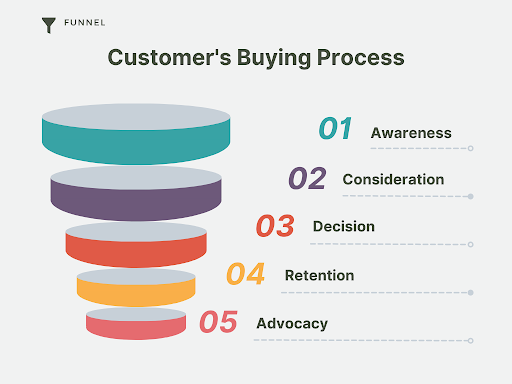15 June 2024 |
By - Sudha Mariappan

When you’re a small brand but you’re ambitious enough to compete with major brands such as Tata Tea or Red Label.
After all your hard work, you’ve created a product that has some unique qualities that you believe would capture the market’s heart. You do everything, from manufacturing the product to launching an ad campaign.
And your product is excellent, but unfortunately, the customers aren’t connecting with it.
Why? The major reason for this is that you haven’t really understood your customer’s journey. As an entrepreneur, taking some time to step into the shoes of the customer is not only important, but also it is the stepping stone of a big, successful sales hit.
You need to be able to determine how the customers discover the product, whether they will consider buying the product (what are their thoughts? ), and finally purchase them.
This is where a Customer Journey Map comes in. Let’s see how a customer journey map helps understand your customer on a more personal level.
What is a Customer Journey Map?
A Customer Journey Map is used when your business needs to have a visual representation of what steps the customers might be taking. This includes first becoming aware of your brand to make a purchase, then considering purchasing to finally buy your product.
It is mapping out the possibilities of any type of interaction that your customer might have during different stages of their buying process.
By knowing the possibilities, you can find the opportunities laid under. It enables you to tailor your approach to better meet your customers’ needs and improve their overall experience.
For example, Nykaa is a leading beauty and wellness e-commerce company in India. It was notable that when they were first launched, they meticulously mapped their customer journey. They are also a great example of e-commerce SEO, which helps with conversions.
They recognized that their customers took the initiative, from browsing makeup tutorials on YouTube to comparing product reviews on their website.
This made Nykaa understand their customers on a personal level, which led them to optimize their website experience. It made it easier for customers to find information about the product, compare it, and make a purchase.
Understanding Your Customer's Buying Process:
Understanding your customers’ stand point of view is important in today’s marketing. People have gotten more aware about every product since there is so much social proof available. Taking notes on how the buying process is conducted is important because it reveals how customers move from being unaware of your product to becoming loyal ones.

This process typically involves several stages:
Awareness: In this stage, customers are relatively new to your product. They are just becoming aware of the existence of your product, so they research what the product could offer. Could it be relevant for them? They can become aware through various channels, such as advertisements, word of mouth, social media, or other channels. For example, a popular milk brand, Amul uses visual appeal like topical cartoons to create awareness and engage with customers.
Consideration: This is the stage after the customer has become aware of your product. At this stage, customers start to see whether your product or brand fits their needs. Customers might compare your product with competitors. They’ll read reviews on various platforms or seek recommendations from others. For example, if customer wants to buy a handbag, they can compare the quality, price of various brands before making a purchasing decision.
Decision: After considering the product, the customer decides to purchase your product. Customers will compare the features of the product along with the price and how the promotions of the product affected them. Customers will only look for the product they will be able to buy. Flipkart is an excellent example of this stage. When customers browse through the website, they see the options of “quick delivery” and “easy returns," which makes the purchase decision easier for their customers.
Retention: As an entrepreneur, you not only have to make potential customers buy the product, but also retain them for a long time.c Customer satisfaction can be the only way to retain your customers. When customers buy your product, provide excellent post-purchase support, and follow up with them in case they have any queries regarding the product. In this way, the customers will feel a sense of satisfaction, which will in turn make them stay with your business longer. Swiggy takes into account the customer’s wishes and uses personalized offers. Their customer service is top notch which retains their customer base.
Advocacy: Turn your loyal customers into satisfied advocates. When people are satisfied with your product, they share their experience in a positive manner. This can attract new customers as well, with their positive referrals and testimonials. For example, Zomato benefits from word-of-mouth recommendations from their millions of loyal customers, due to its efficient service and engaging content.
How to utilize Customer Journey Maps to Personalize Marketing Strategy:
If you know a strategy, the real power is to utilize the strategy in such a way you’ll profit out of it. So understanding the customer journey is just the beginning, the most important part comes when you decide to apply your customer journey map to personalize your marketing strategy.
Below are some of the effective ways you can develop this strategy:
1. Know what resonates with your audience at each stage:
It is easier when you map out the customer journey by targeting content that is suitable to each stage. The best example would be UrbanClap. It is a home services provider in India, which uses customer mapping to create content that resonates with customers at different stages.
When the awareness stage arrives, their main focus is to direct their customers to their blog posts and social media content that usually highlights common household problems, and provide solutions accordingly.
In the consideration stage, they make sure the customer feels right by offering detailed comparisons of various services they offer. They use customer testimonials to help potential customers buy the services.
Finally, at the decision stage they provide clear calls to action and special offers to encourage more customers to book their services.
2. Identify which platform works best for customer journey map:
Each stage calls for different places for communication. It depends on the level to which your business has a relationship with your customers.
The customer journey map effectively helps you with that. It helps identify which communication channels are most effective at each stage of the customer journey.
This will give you the advantage of personalizing your communication strategy based on where the customer is in your journey.
For example, BigBasket is an online grocery delivery service that uses data from their Customer Journey Map to determine the best times and platforms to engage with their customers.
During the awareness stage, they use targeted social media ads to reach new customers.
When it comes to the consideration stage, they play a new game. They follow up with email newsletters with their product recommendations and reviews.
When a customer is finally at their decision stage, they use push notifications and app alerts to offer discounts or remind customers about their cart items.
3. Simplify your Customers user Experience:
Whether it’s an app or a website, because as a business, you’re bound to have one, using customer journey mapping is essential for identifying areas for improvement.
For example, Paytm is a digital wallet like Google Pay and is used primarily for online payments and transactions.
They effectively use customer journey mapping to ease the user’s app experience, which was once filled with complicated steps to even make a single payment.
By simplifying the payment flow and offering multiple payment options, they reduced customer drop-offs and improved overall customer satisfaction.
A simplified user experience will help your business retain customers and improve their overall experience in the long run.
If you’re in need of any assistance regarding digital marketing, connect with us at info@ontogendigital.com. Subscribe to us for more blogs.